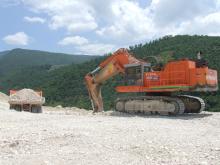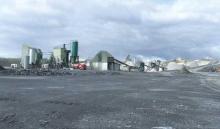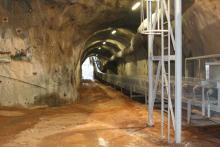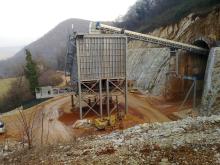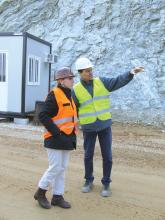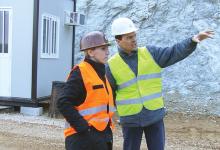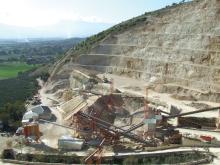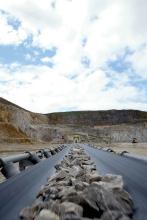
Producing carbon dioxide for a local sugar factory 100 years ago led Italy-based Edilcalce into the quarrying sector. Claire Symes visited the Perugia quarry to find out more
The olive trees that surround the approach to Edilcalce Viola Olinda & Figli's limestone quarry in hills above Eraclio near Perugia in Italy give a hint to the company's origins. But it is only by delving into local history that gives the vital clues about how the business went from producing olive oil and into the building products market.
At the start of the last century the area used to have a factory producing molasses and carbon dioxide was needed to help refine the sugar products. Viola Feliciaro spotted the potential business opportunity 100 years ago and started quarrying the limestone surrounding his olive groves to meet this need.
Today the company still produces olive oil but quarrying forms a much larger, more significant part of the business. The sugar trade has long since moved and the factory has closed and the materials from the quarry are now used by the local construction industry. Running of the quarry is now managed by Viola Feliciaro's great nephew Mario Viola.
"When the company first started to produce lime to siphon off the carbon dioxide for the sugar factory, the material was excavated by hand using pick axes and brought from the quarry to the village by donkeys," explained Viola. "There was a kiln in the village where our office is now located." The lime, which was a by-product of the carbon dioxide production, was used by Edilcalce to produce a lime putty plaster or mortar which was sold locally. "The material was the same as that used by the Romans and the products we sell today are very similar," said Viola. "It was the quality of the limestone that led to the company moving to producing the lime as a product in its own right - the material at our quarry has a very high calcium content and is very strong. The high quality meant that there was a real demand for it in the market and it was that which has driven development of the business, although it was the sugar factory that was the driver in the early years." Edilcalce started out with 10 employees and gradually grew as demand from the sugar manufacturing increased. During this time the company also developed the market for its mortars.
"Political matters interrupted the growth of the quarry, but they did lead to early mechanisation," said Viola. "The German occupation during the second World War led to a stop on production, then after liberation work started once more only to be halted by the presence of the US Army. Once the war was over, work finally did get underway again and we had the chance to buy tracked vehicles from the US Army for use in the quarry.
"With transport of the materials improved, Edilcalce also invested in drills and started to use explosives to blast the limestone and increase productivity. At that time the company was producing two or three truck loads of limestone for processing each day, which is around 100tonnes." Today Edilcalce operates a hi-tech aggregates plant, which was the first automated system in Italy when it was installed by Metso Minerals in 1998. The plant processes around 6000tonnes of material per day and operates for up to 10 hours per day.
Crushed and screened material either goes straight out to the customer or goes onto one of the company's other processing plants. In addition to aggregates for the construction market, Edilcalce also produces ready mixed concrete, lime, mortar and lime putty.
"Around 90% of our production is sold to other customers and the remaining volume is used for production of our own building products," said Viola.
Day to day running of the quarry and production plant is the responsibility of quarry director Roberto Bonifazi, while Viola's son David has been assisting in the quarry for the last five years to learn about the business.
Excavation at the quarry is carried out by blasting. "We usually blast two times a week," said Viola.
The blasts are carried out using 7m long blast holes with an 89mm diameter and spacing of 3.5m. According to Bonifazi, the quarry uses 800kg of ammonium nitrate for each blast and excavates around 4000m3 in each blast.
"The calcium carbonate is very pure in this quarry," he said. "It is around 98% calcium and has no silica in it, which means it is not only very good quality, it is also less abrasive so the wear rate on the equipment is low." The material is loaded into rigid dump trucks using a Hitachi EX1200 excavator - the largest excavator in Italy, according to Viola - before making the 20minute round trip from the active part of the quarry to the primary crusher
The material is screened into seven different sizes and the whole operation is computer controlled and the operator can view the production in real time from the control room. Operation of the Metso Minerals crushing and screening plant is overseen by plant manager Ippoliti Ugo.
"The control room is fitted with CCTV so as well as being able to see the actual production volumes and power use, we can visually check the plant," said Ugo. "Our primary jaw crusher has a capacity at between 500 and 600tonnes per hour and reduces the feed material down to 0-360mm sizes. The material is then fed into an impact crusher and, sometimes also a sand crusher depending on the end product, before it is screened to produce different sized products.
"Five of our products are washed to clean them before they are then fed into hoppers by conveyor for loading into customer's trucks, or delivered into the adjacent fine aggregates and dry mortar plant by another conveyor." Edilcalce's mortar plant is one of its latest investments and the state of the art facility opened in 2006. The plant, which located within the quarry close to the aggregate plant, is managed by Amadei Davide.
"The flow of the material through the plant is all computer controlled," explained Davide. "The material is delivered by conveyor directly into an oven which is used to dry the materials before they are further crushed and screened by Hazemag and Novo Rotor units. Materials under 1mm are transferred to storage silos and then mixed with sand, cement and gypsum to produce various different mortars.
"Some customers prefer to collect the mortar as a bulk product, while others prefer to have them bagged so we have facilities for both here. Both systems are fully automated. On the bagging plant all the operator has to do is select the weight of product to be delivered - most of the time we use 25kg bags.
The lime mortars are produced in another plant located just off the approach road to the quarry and next to the remains of Edilcalce's first plant, which bears a plaque to mark the significance of the old ruined stone buildings and chimneys.
According to Viola, production methods for the lime mortars have remained virtually unchanged and the company still allows the product to mature in caskets before selling the material into the open market. He claims that it is these techniques that separate Edilcalce's materials from others available on the market.
On the opposite side of the main road from the quarry and closer to the village centre, Edilcalce has its concrete plant, laboratories, showrooms, training centre and its own restaurant.
The concrete plant has the capacity to produce up to 600m3 of ready mixed concrete per day but the facility generally supplies around 200m3 of material each day. Viola said that it is important for Edilcalce to add value to the products from the quarry.
The company's research laboratory is managed by Lorenzo Brizi and it is here that development of new mortars and quality assurance of all Edilcalce's products is carried out. Stepping through to the showroom behind the lab, it is clear to see that research and development at the company is a continuous process with display panels of established products alongside Brizi's experimental mixes.
The company has won an environmental award for its concrete and Viola said that testing was a key part of winning that accolade. "Quality assurance is also essential to our lime business,"he said.
The company has restored an old mill next to the concrete plant and laboratory to provide the business with meeting and training rooms, as well as a restaurant to entertain Edilcalce's customers. Viola likes to get involved in this side of the business too and the company's olive oil products are used in the kitchens.
"It is useful for us to have room for providing training for our workforce and also to hold meetings," said Viola.
Inside the walls are lined with images from the quarry's history showing both men with pick axes and donkeys hauling material from the quarry as well as old machines. The display also shows the company's long history of using Hitachi machines, which Viola attributes to Edilcalce's long standing relationship with Italy's Hitachi dealer SCAI, which has offices close by.
Outside in the car park, Edilcalce's heritage is clear with old items of quarry plant, including a railway truck and crushing plant, displayed among the olive trees.
Reverting to nature Olive oil production is still a key part of the Viola-family business and provides Edilcalce with an ideal way of restoring exhausted parts of the quarry. The two businesses are closely linked - the logo for the company is a rock on olive oil. "After we have finished blasting in an area, we cover the bare rock benches with soil and plant more olive trees. We have restored over 30ha of quarry in this way so far," said Viola. "We currently have around 7000 olive trees but it is a very labour intensive industry - each mature tree only produces 20kg of olives and it takes around 100kg of olives to make 30litres of olive oil." According to Viola, the quarry provides the ideal conditions for growing the olives with sheltered conditions to protect the tress during the winter and summer temperatures reaching around 40ºC. "The temperatures are not so good for the equipment and workers though, so we have a siesta during the hottest parts of the day and work later to make up for it," he said.
The company takes its commitment to environmentally sound working practices very seriously and has invested heavily in this area. "We have made several major investments to improve our environmental performance including two purifier plants for industrial water and we have also fitted many filters to prevent air pollution," said Viola. "Sound barriers have also been fitted to provide acoustic insulation on some of our noisier items of machinery." Although Edilcalce is a major employer in the local village with members of around 60 families working at the site, it is firmly committed to maintaining good relations with the whole population. "Recent celebration of our centenary has helped reinforce good feelings with our neighbours but we also sponsor various sports teams and events in the area so we are putting something back into the community," said Viola.
Safe environment Edilcalce is also keen to ensure its workforce have a safe working environment. "The company has suffered injuries in the past like other quarries," explained Viola. "But the company's efforts to eliminate such incidents have led to much better statistical data than that of the national average.
"Although the risks in a quarry for injuries are much higher than other industries, we have found that implementing a well organised system has helped us to avoid severe accidents so our operation is actually safer than other supposed lower risk occupations. The last injury in the quarry itself was in 2005." According to Viola, while the company has improved its safety statistics, it is still working to ensure the trend continues. He said that it is the company's aim to improve the consciousness level of all the people involved in working activities in order to prevent accidents caused by routine and low awareness.
"This is achieved through running a continuous process of control and enhancement of the implemented managing system, which has been certified since January 2008 as conforming to OHSAS 18001," said Viola.
"After having obtained a raw risk elimination or reduction by the systematic review of each process, the residual risk is controlled with continuous training of employees, careful documentation processes, programmed maintenance and clearly marking any potential hazard with signs and alarms."
Future The active area of Edilcalce's quarry currently occupies a 10ha area and the company has reserves with permissions in place to keep the site running for another 20 years. "We will apply for permission to further extend the quarry in the future - there is plenty of room to access other parts of the limestone resource," said Viola. "Gaining permission is complicated but not impossible - approval comes from the Umbria region and each year the region has a set limit for the acceptance of new quarries to try and balance supply with demand." Viola has a keen interest in not just the future of Edilcalce's quarry but also those of others in the region - he is chairman of the Sindacato Confindustria Perugia for aggregates.
But he is also interested in the heritage of limestone in the region and the company has produced a book about the links of the region's prosperity to its limestone. "This region of Italy has been famous for its limestone sculpture for the last 700 years," he said. "Many of the local churches are also built from the stone." Viola started work in the quarry when he was 21 - the third generation of his family to do so - and worked alongside his father Olindo and brother Luciano to gain a good understanding of the business. But he grew up within the business and said that one of his earliest memories is injuring his finger in the site's jaw crusher while helping with some maintenance.
"When I started work here I got involved in every aspect from the production through to the invoicing and trained as an accountant in the office at the same time," he said.
With Viola's son already having five years' of experience in the quarry, the site looks set to be managed by a fourth generation of the Viola family in due course.

